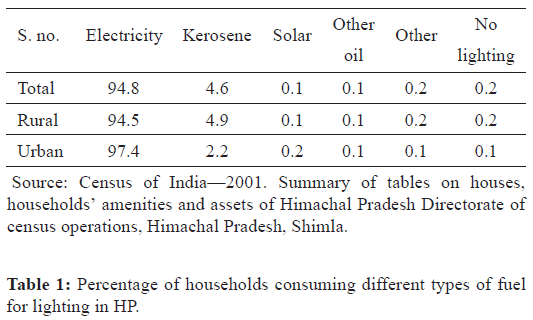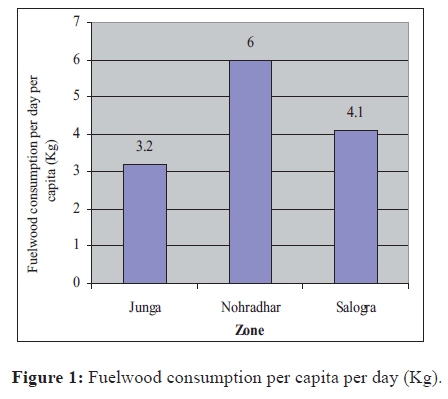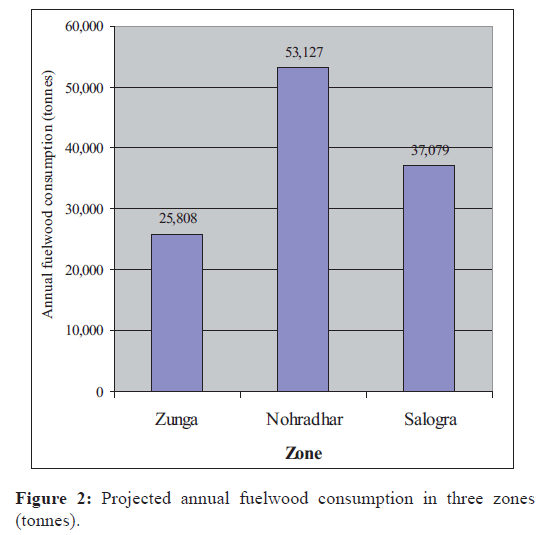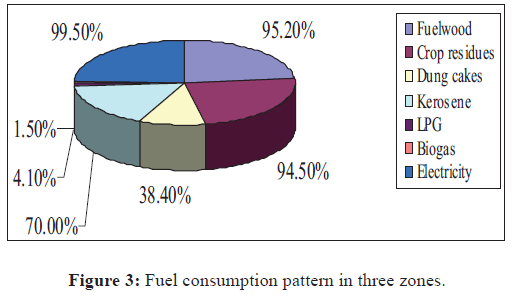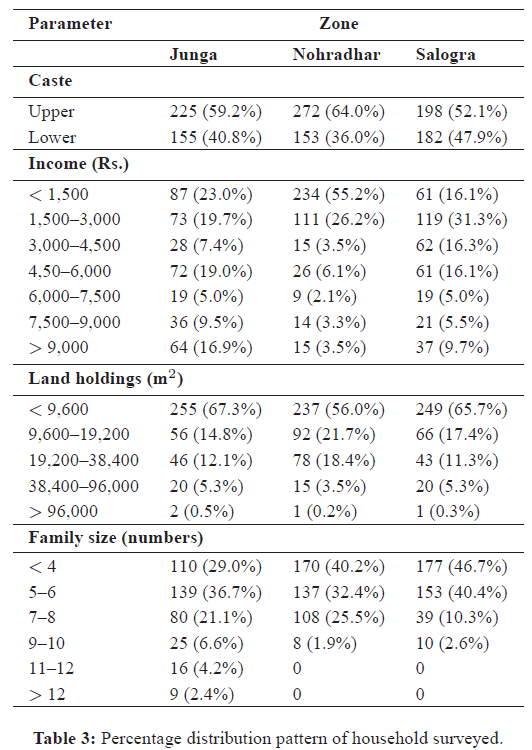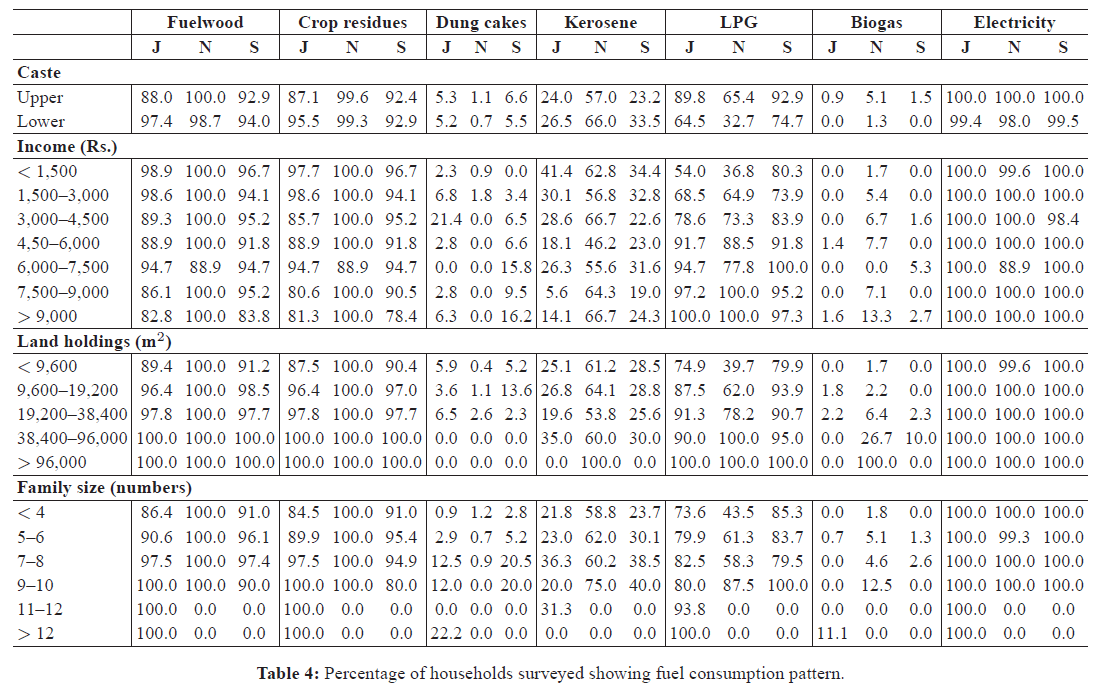Fuel Consumption Pattern for Policy Interventions and Integrated Planning in Rural Areas of India
Received: 18-Dec-2010 / Accepted Date: 30-Dec-2010 / Published Date: 05-Jan-2011
Abstract
A study has been carried out to identify the fuel consumption pattern in rural areas of the state on pilot basis. The study reveals that the present level of use of fuelwood by households (95.2%) is continuing despite the fact that other fuels like kerosene (38.4), LPG (70%) and crop residues (94.5%) are also being used. Based on per capita per day fuelwood consumption, the estimated annual fuelwood consumption works out in Junga (25,808 tonnes), Nohradhar (53,127 tonnes) and Salogra (37,079 tonnes) totaling 0.116 million tonnes in three zones. The time spent by the rural women in collection of fuelwood is also presented in this study. The suggestions for adopting certain specific renewable energy technologies suitable for the area have been presented.
Keywords: Energy; Fuel; Energy consumption factor; Fuel policy
Introduction
Himachal Pradesh is a hilly state of India having a geographical area of 55,673 km2 with population of 6,077,248 [1]. It comprises of 12 districts. It lies in the range of 32° 22' 40'' to 33° 12' 40'' North and in the range of 75° 74' 55'' to 79° 04' 22 East.
The flora and fauna of the state as well as the mode of living and outlook of its people is governed by its climate that varies according to the elevation. The terrain changes from South to North. The lower foothills are part of Shivalik ranges and rise up to about 1,200 meters above mean sea level (amsl). Thereafter, the ranges soar up to about 7,000 meters. The climate also varies from mild to extreme cold accordingly. The whole state can be divided into four agro-climatic zones as indicated in the following.
Low hills: these have an altitude up to 1,000 meters amsl and are most suitable for fruit crops for which the state has earned a name. Mid hills: this area lies between 1,000 and 2,000 meters amsl. These are sparsely populated and are considered good for raising forests. High hills: this area lies between 2,000 and 3,000 meters amsl. These provide rich pastures and meadows to goats and sheep. Cold and dry zone: This area, lying above 3,000 meters, (amsl) is covered by perennial snow and has no vegetation whatsoever.
Notwithstanding the fact that conventional fuels are depleting and are available for a limited period, dependence on them is increasing. These fuels are highly subsidized. Kerosene and LPG are imported to the extent they fall short of our production. The other important conventional fuel is electricity which is presently available in abundance in the state at subsidized low cost. On the other hand, there appears to be no let up in the use of fuelwood and crop residues.
The scenario in the energy sector appears to be quite depressing. The necessity of adopting renewable energy technologies (RETs) was not brought home to the people with the intensity it should have been done. Even today people are not aware of the urgency to switch over from conventional energy to RETs. In fact, the dependence/burden on the use of conventional energy sources is ever increasing with automation of each and every activity of daily life.
In case alternative energy fuels are not timely harnessed in right earnest, the dependence on conventional fuels will go on increasing manifoldly. The obvious result would be that they will exhaust sooner than expected. Again, if the subsidy on conventional fuels was withdrawn or otherwise the cost of such products increased, the dependence on forests in rural areas would further increase besides causing energy crisis in urban areas also.
The indiscriminate use of wood is already degrading and depleting the forest cover besides drastically reducing the water table. In case this exploitation goes on unabated, the situation will further worsen. This will also adversely affect the land use pattern. Therefore, unless remedial measures are immediately taken, we can not hope for a better tomorrow.
The conventional sources of land, water, fuel and so forth are depleting due to a variety of factors like population growth, industrialization, metalling of roads and change in land use and living pattern. Availability of land is decreasing for agriculture and forestry purposes; indiscriminate deforestation is adversely affecting the land use pattern; and availability of water is decreasing. If non conventional energy sources (NCESs) are tapped, land can be more judiciously used for cultivation and aforestation. Till the recent past, conventional resources were seemingly considered to be available in abundance, as such, necessity of finding out alternative non-depleting sources was not felt to the extent it is being felt today because of indiscriminate use of these sources.
The existence of all living beings, including animal and plants, has always been dependent on land. Quality of life is determined by the availability of various natural resources, such as water, forests, flora & fauna, and cattle. There are certain other external factors which may not be directly related to the resources available on land but they do materially affect the quality of life by prolonging the use of existing perishable resources. Thus, these external resources substantially supplement the behavior of the land and soil. The most prominent among these external resources are the NCESs like solar energy, bio-energy, tidal energy, wind energy and so on.
Although no energy policy at national level has so far been formulated, yet the central government took a number of initiatives to harness NCESs in all their forms and took it up as a national program to be implemented through the states for which liberal financial assistance was provided. It is only in India that there is a separate Ministry of New and Renewable Energy (MNRE) to frame policy and monitor the various programs initiated by the state governments and to provide grants on the basis of programs formulated and achievements made by them.
The yardstick of development is taken to be the availability of material facilities to the people. This indicator determines the quality of their life. Conversely, it is true that more the facilities, sooner the depletion of conventional energy resources. For instance, we take pride in providing LPG connections to people living in remotest corner of the country but we forget to realize that the source of LPG is limited and bound to finish more rapidly. This preposition is equally true in utilizing the forest wealth, indiscriminate use of which is not only disturbing the land use pattern but also degrading our environment. Therefore, before it is too late, we have to realize the urgency and necessity of exploring alternative energy sources the need of which is now being felt globally.
Renewable Energy Program In Himachal Pradesh
In Himachal Pradesh, the utilization of NCESs is directly linked with the broader objective of optimum land use by preserving forest wealth and protecting environment and also by prolonging the availability of existing conventional energy sources. Hence, it is necessary to identify the availability of NCESs in the state with a view to harnessing the vast potential of solar and bio-energy in particular and other NCESs in general for cooking, heating, lighting and for various other purposes.
Although the state is contributing a negligible 0.35% of the national total air pollution due to use of coal, petroleum and from industries, yet the impact of global warming in the state will be severe.
It was in this background that a study on energy survey in rural areas on pilot basis was entrusted to the Department of Basic Sciences, Dr. Y. S. Parmar University of Horticulture & Forestry, Nauni (Solan) by the Director, Land Use Board, State Forest Department, Shimla.
In HP to achieve one of its main objectives, to conserve the forest wealth by ensuring economy and efficiency in the use of fuelwood for domestic and other purposes, MNES implemented and executed various programs for NCESs through the state governments. For this purpose, in HP the State Energy Development Agency (HIMURJA) was established in mid 80s. In the initial stage, the state Rural Development Department (RDD) and Agricultural Department (AD) implemented some of the programs, such as biogas and improved cookstoves. After the setting up of HIMURJA, the departmental initiatives were shifted to it. HIMURJA did implement some of the programs of GOI like solar light, solar cooker, solar water heaters, improved cookstoves, improved kerosene stoves and so forth. These programs were executed till the funds were provided by the GOI and handsome subsidy was available on various technologies. However, when the central assistance started decreasing and subsidy withdrawn all these programs came to a stand still.
The State Forest Department has entrusted a study to carry out rural energy survey on pilot basis in three different zones of Himachal Pradesh to identify the utilization of energy sources in a watershed area for policy interventions and integrated planning.
Strategy/methodology
Selection of area
In order to make the study a representative one, the guiding factor was to include both types of areas, i.e. the one nearer to urban settlement and the one situated in remote localities. Accordingly, 12 Panchayats of Zila Parishad Ward, Junga, sub-tehsil of District Shimla, 13 Panchayats of Zila Parishad Ward, Salogra of tehsil and District Solan and 15 Panchayats of Zila Parishad Ward, Sub tehsil, Nohradhar of Sirmour District were selected. Whereas Zila Parishad Ward, Junga and Zila Parishad Ward, Salogra are urban biased, Nohradhar Sub tehsil is remotely situated.
Selection and scope of household
In order that the study becomes broad-based as also to elicit the information and views from all sections of the society, it was thought appropriate to cover every ward of each Panchayat proposed to be taken up under the study. It was reasonable to select at least five households in each ward representing one Integrated Rural Development Programme (IRDP) household, one schedule caste household and one household each covered under low, middle and higher income group. The selection of samples under these categories was made on random basis. During the survey, 8.7% of the total households and 8.9% of the total population in three zones were covered.
Development of questionnaire
After detailed discussions with the experts from universities, sponsoring agency, Non Government Organizations (NGOs) and keeping in view the objectives and expected outcome of the study, different questionnaires were developed for the following types of respondents:
(a) individual households to get individual views regarding energy consumption pattern and energy needs of the household;
(b) group discussion for eliciting the views of the community at ward and Panchayat level to get collective views regarding energy consumption pattern and energy needs at community level in participatory mode;
(c) identification of local artisans to get information regarding artisans available for training and their willingness for fabrication of RETs.
Survey strategy
(a) Identification of Field Investigators
Identification of Field Investigators was done in consultation and collaboration with the Panchayati Raj Institutions (PRIs) and Mass Volunteer Organizations (MVOs) working at the grass root level. Keeping in view the magnitude of these surveys, at least one Field Investigator was identified from each ward. Field Investigators were selected locally, because they were familiar to local people, could intimately interact with them and could give better and authentic results.
(b) Training
The selection of Field Investigators was followed by their extensive training/orientation at Nohradhar, Shimla and Solan. The training contents included the introduction to various schemes of the different departments involved in the field of RETs and how these will benefit the rural people individually and at community levels. The contents also included how to get the responses to the questionnaires, how to conduct group discussions and elicit collective views of the people in order that all such views were reflected in the study. Further, the training was imparted on how to get authentic information about the rural artisans at local level and who, if interested, could be trained in RETs.
Analysis
The study was conducted in three different zones depending upon their geographical and socio-economic conditions. As a strategy, each ward was covered in a selected area and, as far as feasible, five households in each ward representing different sections of the society were taken up, thus giving the study a true representative character.
Accordingly, the study was based on the four parameters, namely, (i) caste, (ii) income, (iii) land holdings and (iv) family size of each family.
Initially, the composition of households surveyed has been analyzed. This composition has been tabulated in Table 1. The composition of households given in this table forms the basis of working out percentage shown in this table that follows in this chapter.
Based on castes, households in lower caste are the minimum in Nohradhar (36%) and the maximum in Salogra (47.9%).
On the basis of income, the households having income <Rs. 1,500 are the maximum (55.2%) in Nohradhar and the minimum (16.1%) in Salogra. The households with income more than Rs. 9,000 are the maximum (16.9%) in Junga and the minimum (3.5%) in Nohradhar. It will also be interesting to note that in all the three zones the households under income group Rs. 6,000–7,500 are the least (Junga 5%, Nohradhar 2.1% and Salogra 5.5%).
The distribution of households on land-holding basis in all the three zones works out to be maximum with holdings <9,600 sq.m (Junga 67.3%, Nohradhar 56% and Salogra 65.7%). As the land holdings increase, the number of households in all the three zones has shown a decreasing trend.
Family size wise, the households having <4 members are the least (29%) in Junga as compared to Nohradhar (40.2%) and Salogra (46.7%). Households with family size 5–6 are the maximum (40.4%) in Salogra in comparison to other zones (Junga 36.7% and Nohradhar 32.4%). Again, while the family size 9–10 in Junga constitutes 6.6%, it is negligible in Nohradhar (1.9%) and Salogra (2.6%). The table further reveals an interesting fact that whereas in Nohradhar and Salogra there exists no family consisting of more than 10 members, in Junga it is 6.6% (family size 11–12 4.2%, >12 2.4%). It can, therefore, be safely inferred that as compared to other two zones, households in Junga are composed of larger families.
Fuel consumption pattern
The analysis of households using various types of fuel has been tabulated in Table 2. This table indicates the pattern of fuel consumption for cooking, lighting, heating and cattle feed preparation. In all the three zones, the major fuels used are firewood, crop residue, kerosene, LPG and electricity while dung cakes and biogas are used by very small number of households.
As per this study, the estimated annual fuelwood consumption, on the basis of the population (2001 Census) of the three zones, is presented in Figure 1 and total fuelwood consumption of three zones works out to be 0.116 million tonnes.
Findings And Inferences
From the detailed analysis and as a result of group discussions held atWard and Panchayat level, the inferences drawn have been presented in this paper.
(1) The study reveals that the number of households in smaller family size below 4 and 5–6 is higher in all the three zones (Junga 65.7%, Nohradhar 72.6% and Salogra 87.1%).
(2) The pattern of fuel consumption indicates that the major fuels used are, fuelwood (95.2%), crop residues (94.5%), kerosene (38.4%), and LPG (70.0%). Dung cakes (4.1%) and biogas (1.5%) are used in very small quantities, in specific areas, while 99.5% households use electricity mainly for lighting purposes. Firewood and crop residues are used for cooking and heating purposes. Kerosene oil is used for all the three purposes in varied degrees. LPG is used for cooking only.
(3) Fuelwood and crop residues are not purchased by any of the households, therefore, these fuels are extensively used in preference to other fuels. The crop residues consist of maize stalks & cones, pine needles & cones and other dried plant wastes. These residues are obtained by the users from their own fields. The crop residues (34.2%) are also in use for preparation of cattle feed.
(4) Per capita per day consumption of fuelwood has been worked out 3.2Kg in Junga, 6.0Kg in Nohradhar and 4.1Kg in Salogra (Figure 2) from which it is inferred that the consumption of fuelwood is more in remote areas than in localities which are nearer to urban settlements due to the use of other alternative fuels. Based on per capita per day fuel wood consumption, the estimated annual fuelwood consumption works out in Junga (25,808 tonnes), Nohradhar (53,127 tonnes) and Salogra (37,079 tonnes) (as shown in Figure 3) totaling 0.116 million tonnes.
(5) Fuelwood is mostly collected by women along with children from nearby forests located from 1 to more than 6Km away from home and are brought on head load. The time spent is on an average, 30–40 hours per month to collect fuelwood and bring to home.
(6) During group discussions, it transpired that fuelwood collected from the forests consists of shrubs, bushes, dried fallen branches, dried plant roots and solid trees mainly for use during winter. Though solid tree wood constitutes a major chunk of fuel wood, it is not possible to quantify it. Every body agreed that cutting of trees was adversely affecting the forest wealth as well as ecology more particularly because there was no replacement by the villagers in place of the removed trees which ultimately taken to the base for drawing the inferences.
(7) The present level of use of fuelwood by households (95.2%) is continuing despite the fact that other fuels like kerosene (38.4), LPG (70%) and crop residues (94.5%) are also being used. Had this not been the position, the pressure on forests for fuelwood would have been much more, resulting in fast degradation of land and adversely affecting the land use pattern in the state.
(8) Kerosene is in use for cooking, heating and lighting. As compared to areas located nearer to urban settlement (26.8%) it is more used in remote areas (61.5%). On the other hand, in areas near to urban localities (80.5%) LPG is in greater use than in remote areas (49%). LPG is being mainly used for cooking. These fuels are available at subsidized cost, therefore, there is willingness among the rural people for their use. The study reveals that there is still greater demand in rural areas for these fuels (63.1%). During group discussion, however, every body agreed that if and when the subsidy on these fuels is withdrawn (which is likely to happen) the people particularly in low income groups may not be able to continue their use and may have to revert to fuelwood, thus causing much more severe strain on the forests.
(9) The study further reveals that dung cakes (4.1%) and biogas (1.5%) as fuels are not in use, except in negligible households. This is in spite of the fact the cattle are being maintained in every households. The dung as a fuel is not being used because it is used as manure in the fields.
(10) During group discussions, it was gathered that people had preference for biogas as a fuel for cooking and lighting. However, they were unable to do so due to lack of technical know-how and dissemination of proper guidance on the part of the department/agency concerned with regard to neither their maintenance, nor any effective programs for awareness have been launched.
(11) Electricity is being used mainly for lighting purposes in rural areas. The study reveals that the monthly bills on this account are within the affordable cost ranging Rs. 100–300. The cost of electricity in the state is again subsidized and is much cheaper than in other states. The supply of electricity is uninterrupted with very few breakdowns. However, if and when the tariffs are increased or subsidy is withdrawn, it may be that in lower income groups cost of electricity becomes beyond their affordable capacity.
(12) There is still preference of fuel for wood in lower caste households (41.1%), LPG in upper caste (81%) and biogas for cooking in remote localities (4.8%). Electricity is the most preferred fuel for lighting.
(13) During the last five years 20% to 27% of households changed from one fuel to another due to a variety of factors, some of which were that traditional fuel became scarce or its carriage involved more distance and time or the new fuel was not convenient and easily available or the new fuel was found to be more efficient and less hazardous.
(14) Level of awareness about various energy devices is very low although 25% to 65% of people had some information about the energy devices. But as gathered during group discussions, the people were not aware of their use and necessity. However, the people were made aware about the use of RETs during survey operations. They were keen to know more about these technologies.
Suggestions For Adopting Certain Specific Technologies
(i) Biomass
The large portion of crop residues produced every year is either wasted, or used inefficiently. The agro/forest waste, if it is used as briquettes, it can provide a renewable source of energy without the addition of any binder. Briquettes have high specific density (1,200 kg/m3) and bulk density (800 kg/m3) compared to 60 to 180 kg/m3 of loose biomass [1]. It has high thermal value and low ash content compared to coal. In the three zones under study, 94.5% of households use crop residues. The briquettes are made using briquetting machines which can be operated by a person at local level. The cost of machine may initially be subsidized and wages for a person can be met out of the sale of the briquettes.
(ii) Solar passive house technology
The people in the state experience severe winter during November to March; thus, space heating is required which is being met out by using wood burning cookstoves in rural areas and electric heaters in urban areas. The state government provides wood to remote areas of the state on subsidized rates by importing from lower belts as the electric breakdowns are common in remote areas. This necessitates the use of solar passive features in buildings. Keeping in view the cold climate of the state, the government has made it mandatory to incorporate solar passive features in all those government buildings which are constructed at an altitude of 2,000 meters or above. However, there are no guidelines for private house constructions. The solar passive features, if incorporated at the time of construction, may increase the initial cost by about 10%; but this increase is set off by the benefits and savings in direct recurring cost involving in heating the building. This will reduce the fuel bill of the people besides reducing the burden on the forest.
(iii) Solar photovoltaic program
The state has 250–300 sunshine days in a year. There is vast potential of solar photovoltaic technology in the state particularly in the remote areas where electricity breakdowns are common or electricity not provided and conventional fuel is also not cost effective, and consequently the solar light has proved to be a boon. About 37,738 of solar domestic light and solar lanterns (0.1%) have been provided and 2,753 solar street lights have also been installed in the state by subsidizing the cost (Table 3). About 5% of households use kerosene for lighting in rural areas. If solar lights are used for lighting, they will reduce the burden on electricity as well as on kerosene.
(iv) Solar cooker
Research has found that 36% of the world’s fuelwood needs (or 350 million tonnes of wood per year, according to UNICEF) could be replaced by solar box cookers, saving 500 Kg of wood per family per year, equaling millions of trees. Solar box cookers can pasteurize drinking water; heating water to 65 °C for six minutes destroys disease organisms, and this temperature is easily achieved with solar box cookers. The use of solar cooker will not only reduce the pressure on LPG and wood but also will help in conserving the environment. About 30,000 solar cookers have been distributed in the state at that time when wood was available easily in rural areas and LPG/kerosene was in use in urban areas on subsidized rates.
(v) Biogas
Biogas technology provides an alternate source of energy in rural areas. This gas can serve as a convenient fuel that can be used for a variety of applications, such as cooking, lighting, and motive power. The slurry that comes out of biogas plant after the gas is produced can be used as an organic manure in the fields to augment soil fertility. Thus, biogas technology produces fuel as well as fertilizer, while only one of these is possible if dung is used in its original form.
One kilogram of dung produces about 40 liters of biogas. A family size biogas plant (two cubic meters) requires 50Kg of dung and equal amount of water to produce 2,000 liters of gas per day. Biogas technology makes optimal utilization of the valuable natural resource of dung; it provides nearly three times more useful energy that dung directly burnt, and also produces nutrient-rich manure.
As a cooking fuel, it is cheap and extremely convenient. Based on the effective heat produced, a 2m3 biogas plant could replace, in a month, fuel equivalent of 26 Kg LPG (nearly two standard cylinders), or 37 liters of kerosene, or 88 Kg of charcoal, or 210 Kg of fuelwood, or 740 Kg of animal dung. In terms of cost, biogas is cheaper, on a life cycle basis, than conventional biomass fuels (dung, fuelwood, crop wastes, etc.) as well as LPG, and is only fractionally more expensive than kerosene; the commercial fuels like kerosene and LPG, however, have severe supply constraints in the rural areas.
The estimated potential of biogas plants in the state is 1,25,600 against which 44,123 plants have been installed in the state up to December, 2002 [1]. There are 2.2 million cattle in the state which can generate biogas to meet out the rural energy demand of cooking and lighting [2].
(vi) Solar water heater
A large quantity of wood, kerosene and crop residues is used for water heating in the state during winters. The solar water heater can save conventional fuel like wood and kerosene used for water heating. A solar water heater with capacity of 100 liters per day can save 2,138 Kg of wood, 374 liters of kerosene and 2,230 units of electricity. The use of solar water heater in rural areas can save huge amount of fuelwood and kerosene. Current prices of domestic SWHs are around Rs. 22,000 for a 100 liter per day (lpd) system. The life-cycle cost of energy of saved electrical energy is Rs. 6,000 per year at the point of end-user. If the SWH is purchased as an add-on to an existing geyser, the simple payback period for the consumer would be 5.5 years. If the SWH is purchased instead of a conventional geyser, the payback period for the consumer would reduce to 3.6 years.
(vii) Improved cookstove
An improved cookstove can save fuelwood 700 Kg per family per year besides improving the domestic environment and reducing drudgery of women and children. Indian government has launched National Program on Improved Cookstoves which was implemented by State Rural Development Department (RDD) and HIMURJA in the state. HIMURJA has installed about 0.16 million of different types of improved cookstoves in the state. Table 4 reveals that the material used for roofs are such that the pipe fixing in kitchen is a major cause for demolishing of cookstove due to constant leakage of water through roofs. In order to revive the use of cookstove chimney hood system needs to be introduced at the time of construction of the kitchen so that domestic air pollution could be reduced.
Conclusions
The major fuels used are fuelwood (95.2%), crop residues (94.5%), kerosene (38.4%), and LPG (70.0%). Dung cakes (4.1%) and biogas (1.5%) are used in very small quantities, in specific areas, while 99.5% households use electricity mainly for lighting purposes. Based on per capita per day fuel wood consumption, the estimated annual fuelwood consumption works out in Junga (25,808 tonnes), Nohradhar (53,127 tonnes) and Salogra (37, 079 tonnes) totaling 0.116 million tonnes. In order to meet out energy requirement of the rural people, the renewable energy technologies are the better option as these are also environmentally friendly. This will save the time and labor of the rural women spent in collection of fuelwood.
References
- A Newsletter of the Ministry of Non-Conventional Energy Sources, 2005. Vol. 1, Issues 2 & 3.
- Directorate of Census Operations, Himachal Pradesh, Shimla, Census of India, 2001. Summary of tables on houses, household’s amenities and assets of Himachal Pradesh.
Citation: Aggarwal RK (2011) Fuel Consumption Pattern for Policy Interventions and Integrated Planning in Rural Areas of India. InnovativeEnergy Policies 1: 103.
Copyright: ©2011 Aggarwal RK. This is an open-access article distributed under the terms of the Creative Commons Attribution License, which permits unrestricted use, distribution, and reproduction in any medium, provided the original author and source are credited.
Share This Article
Recommended Journals
Open Access Journals
Article Usage
- Total views: 13951
- [From(publication date): 12-2011 - Jul 17, 2024]
- Breakdown by view type
- HTML page views: 9629
- PDF downloads: 4322

